Subscribe to blog updates via email »
January 2022 Income Report
An audio version of this income report is available to Patreon backers of certain levels »
January’s income was $8,490, down from December’s $10,130. Profits were $5,059, up from December’s $5,008.
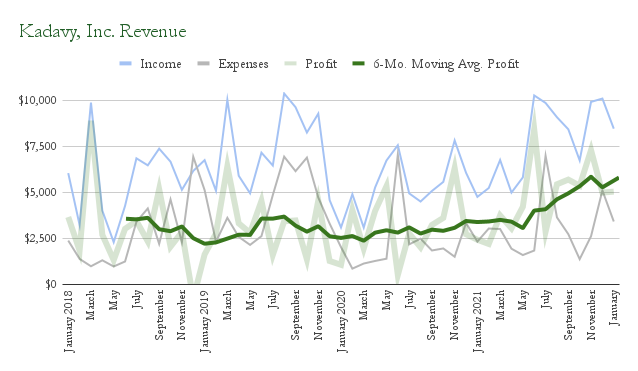

WANT TO WRITE A BOOK?
Download your FREE copy of How to Write a Book »
(for a limited time)
Record revenue (eight month streak!)
January was the eighth month in a row with a new record for twelve-month revenue. I’ve earned $95,971 in the twelve months leading up to the end of January. I’m getting close to that psychologically-significant six-figure mark of $100,000.
This is the eighth month in a row I’ve broken my record for revenue over a twelve-month period. This streak started in June, when my twelve-month revenue was $72,053. So, my twelve-month revenue has grown by 33% over that period.
Record profit (eight month streak!)
Record revenue doesn’t always mean record profit, but for the past eight months, it has. My profits over the twelve months leading up to the end of January have been $58,533. I previously reported that I had broken the $60,000 mark, but it turned out I had an error in my spreadsheet. So, I’m still a little shy of making “as much as a teacher.”
This is the eighth month in a row that I’ve broken my twelve-month profit record. I started my streak in June with twelve-month profits of $44,896. So, while my revenue has grown 33%, my profits have only grown 30%.
Record profits over twelve months also means record monthly profits. I’m averaging $4,878 profit in the past twelve months.
Record book revenue
I also broke my twelve-month record for self-published book revenue. In the twelve months leading up to the end of January, I’ve made $62,557 in self-published books, alone. This is a streak, but not as long of one. This is the third month in a row I’ve broken this record.
Record book profits
Though I don’t have an eight-month streak in book-revenue records, I do have an eight-month streak in book-profit records. In the twelve months leading up to the end of January, I’ve earned $35,065 in self-published book profits.
I started this streak in June, with twelve-month profits of $19,814. This is massive growth of 77% in self-published book profits, over that period of time.
Naturally, my average monthly profit from self-published books over the past twelve months is also a record. I’m averaging $2,922. I started an eight-month steak of growth in June, with an average of $1,651. Again, that’s a growth of 77%!
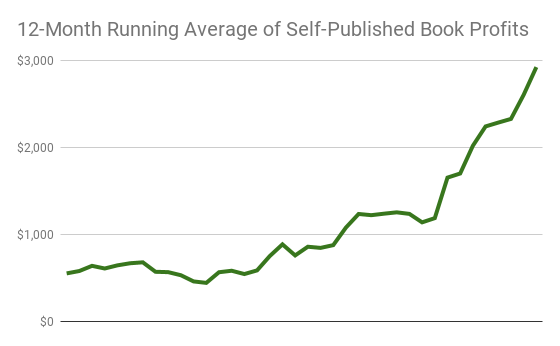
Logarithmic graph?
Looking at the graph for my average monthly self-published profits, I can’t help but notice that the recent changes look impressive, and the earlier changes look not as impressive. But here’s what the same graph looked like back in November 2020, with a doubling in profits circled.
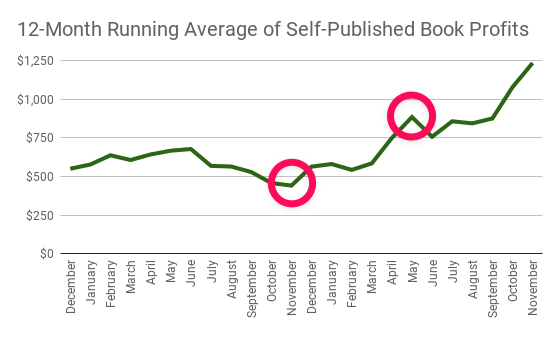
There was a doubling in profits, then there was another doubling in profits. That prior doubling of profits gets lost in the new graph, which prevents me from seeing just how far I’ve come. Maybe I should be trying a logarithmic scale? That would look like this.
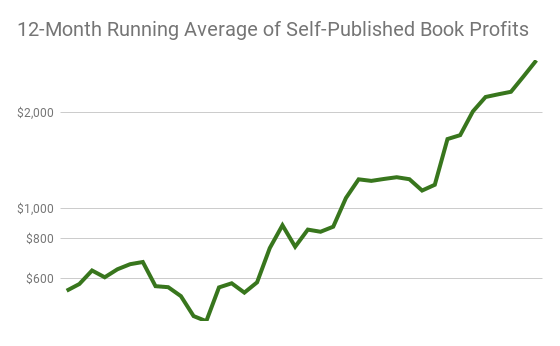
There, a doubling of profits looks like a doubling of profits. The dips in profits also look big!
Here’s what a logarithmic scale looks like if I apply it to my overall profits.

That dark green line is a 6-month moving average, and as you can see, it’s on a backdrop of extreme peaks and valleys in income, expenses and profits. It really drives home that creative work happens in Extremistan, not Mediocristan.
Record one-month book profits
Not only did I break my record for book profits over the previous twelve months, I had the highest-ever profits for a single month from self-published books in January. When I subtract my advertising expenses of $2,547 from my revenue of $7,407 from books, I see I profited $4,860. This is a two-month streak.
Mind Management, Not Time Management profits surpass The Heart to Start
Mind Management, Not Time Management and The Heart to Start are the two books for which I tally all numbers from all channels, to keep track of sales, revenue, and profits. This month, MMT surpassed HTS in profits!
This is impressive, considering that MMT has been out for just fourteen months, and HTS has been out for more than four years.
| Book | Copies Sold | Revenue | Expenses | Profit |
|---|---|---|---|---|
| MMT | 11,410 | $43,068 | $21,149 | $21,919 |
| HTS | 24,173 | $78,884 | $58,420 | $20,464 |
While I’ve sold more than double the copies of HTS than MMT, and spent nearly three times as much promoting HTS as I have MMT, I’ve still made a higher profit on MMT. How?
Why has MMT been more successful, faster?
One reason is that about 3,000 of the HTS copies I’ve “sold” were actually free. I gave the book away the first several days it was launched. I’ve never offered MMT for less than $1.99, and that was just for a BookBub Featured Deal (if I don’t count that Amazon once discounted it to £0.99, in the UK).
Another reason is that I made about $4,000 on MMT before it even launched, by releasing a Preview Edition.
Another reason is HTS was my first self-published book. Each book you add to your catalog adds another “entry point” into your universe. The more books you add, the more readers of each book have a chance to buy other books. The entire time MMT has been out, I’ve had a catalog of one major book (HTS), and several short reads, all which probably contribute to MMT sales.
Yes, HTS sales have probably enjoyed benefits from this “snowball effect,” but the book is already several years old. Books tend to sell the most copies in the first few years of their lives. For much of the life of HTS, the only other book I had in my catalog was Design for Hackers, which was already six years old by the time HTS came out.
The final reason is MMT is probably just an easier book to sell. The title is somewhat memetic, and motivates sharing on social. It’s a longer book, and fits neatly into the existing-and-already-hot category of Time Management.
$1,000 of Mind Management, Not Time Management Audible income!
In November, I reported that an Instagram account with a million followers shared MMT. That actually happened in December, and it led to an explosion in paperback sales, and record monthly book revenue.
Audiobook sales reporting, however, is always delayed a couple months, so it wasn’t until this month’s report that I got to see the effect this had on my audiobook sales. I sold 366 units on Audible, which brought in $1,012 in revenue. My average monthly revenue from MMT on Audible in 2021 was only $205, so this is a big gain.
The boost I experienced on wide audiobooks through Findaway Voices was less substantial, however. After averaging $38 per month in 2021, my revenue for January through this channel was only $138.
How much money did I lose by not being Audible-exclusive?
If you recall my internal debate when I decided to go wide with audiobooks, to go non-exclusive with Audible, I had to go from a 40% royalty rate to only 25%. So, by not being exclusive, I missed out on about $600 of revenue from Audible. That wasn’t made up by the $138 I brought in from Findaway Voices. When you consider that some of that revenue includes Apple, which would be added to my Audible/ACX revenue, were I exclusive, it looks even worse.
Yeah, that stings a little, but I’m still committed to being wide. I realize it’s something you probably have to put some effort into if you want it to make sense financially. Unfortunately, I’ve submitted MMT for a Chirp audiobook deal several times, and been rejected every time. That’s strange, considering the HTS audiobook was accepted a while ago. I’ll just keep trying.
Polish rights sold for Digital Zettelkasten!
I’ve sold the rights for the Polish translation of Digital Zettelkasten. It will be translated and published by Helion. They happen to be the same publisher that bought the Polish rights to Design for Hackers years ago, through the book’s publisher, Wiley.
For 5 years of worldwide rights, we agreed upon a $1,300 advance. Some of that is being withheld for Polish taxes, and you’ll see the final number in next month’s report.
Follow up!
I had been wanting to announce this for a while, but it took a long time to make the deal. I got my first query on May 28, 2021, just four days after I published the book, so it took at least eight months to make the deal and receive payment!
If you’re selling foreign rights for one of your books, be patient, and follow-up like crazy. They will drop off the face of the earth if you don’t. In fact, looking at my email history, I did in fact follow up with them in October, after sending them a sample in May. Then they offered me the deal. I may have never have heard from them had I not followed up!
More foreign-rights deals?
This is the second foreign-rights deal I’ve made for a self-published book. You may recall from a previous income report that I sold Vietnamese rights to The Heart to Start. I have other titles being reviewed by other foreign publishers, so I hope to make more deals.
I’m actually surprised Digital Zettelkasten attracted interest, as it’s only eighty pages long. I’ve received feedback that HTS isn’t a good translation target because it’s not long enough, but maybe that’s a convenient excuse?
Foreign rights deals are a great way to make extra money for intellectual property you’ve already created. Like Jack Butcher says, make once, sell twice!
Title testing for next book
One reason MMT has made a profit faster than HTS is that it had the luxury of being added to an already-existing catalog of books. This thought is one thing keeping me going as I work on my next book.
It’s to be the third and final (?) book in my “Getting Art Done” trilogy. HTS was about starting projects, MMT was about making progress on them. This book will be about finishing them.
I’ve already been workshopping ideas in tweets, newsletters, and on the podcast. But now, I’ve started being more intentional about trying to find a good title.
Testing as I create
There are a few ways I test out titles as I create:
- As tweets
- As newsletter subject lines
- As podcast article titles
When I tweeted “Productivity is less about time management than it is about mind management,” in 2012, it got 125 likes and 210 retweets. I then wrote a blog post about it, and that did very well, including connecting me with Timeful, which later sold to Google.
People are a lot more stingy with the retweets these days, but I still use Twitter as a great testing bed for ideas. If an idea does well on Twitter, it will usually do well as a newsletter topic or article.
Some ideas I’ve shared that are potential titles for my next book:
- I’ve tweeted “Finish what matters (forget the rest).” It got 11 likes. Not overwhelming, but not bad. It could be expanded or otherwise adapted to tweet form.
- I’ve tweeted about how “shipping is a skill.” It got 18 likes. Better, but it’s better-adapted to tweet form, too.
- I also wrote an article about how shipping is a skill. It’s one of my more-listened podcasts recently, and Joel Gascione of Buffer liked it enough to tweet it, so that’s saying a lot. But even with his 73k followers, it only got 15 likes.
- I’ve tweeted a lot about shiny object syndrome, and my podcast episode on it is my most-listened recent one. People have a problem with it. Though including shiny object syndrome in a book title doesn’t pass the “cocktail party test.” It doesn’t exude the optimistic posture that attracts people to a book title. It will definitely be mentioned in the book description, and probably in a chapter title. Maybe it can make an appearance in the subtitle.
BookBub ad tests
Another way I test titles, once I’ve narrowed down some options, is by running tests on BookBub Ads. I make a generic landing page, and I put a painfully-generic book cover in an ad, like this:
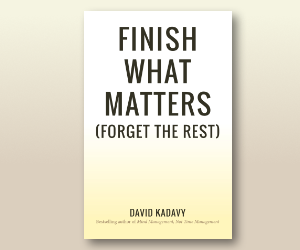
Then I run small tests against other ads with painfully-generic book covers, with different titles.
Here are the results from a recent batch of tests, run against an audience of Stephen Pressfield readers.
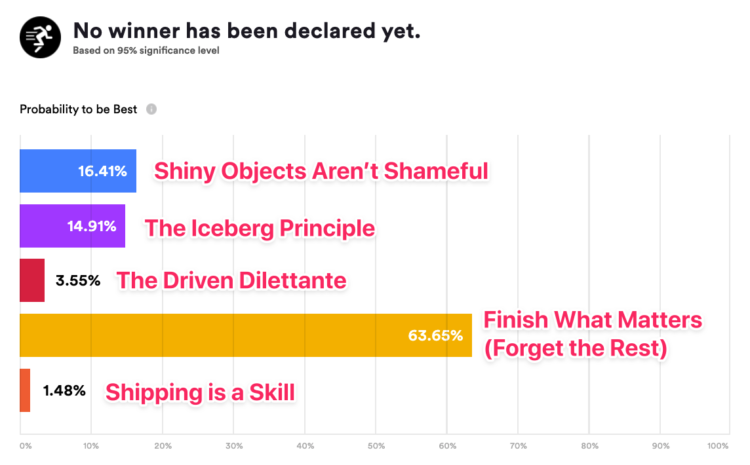
That might look convincing, but it’s really not. It would cost a ton to get enough data for conclusive results, so this is just the data plugged into a Bayesian calculator.
Coming up with a good title is ultimately more art than science, but testing ideas in various ways at least gives me a clue as to what is high-impact, and what is not. Though it’s all subject to methodological flaws, and you have to go with your gut to some extent.
What the f*ck is wrong with Twitter?
Testing ideas on Twitter has been tricky the past several months, because their algorithm has changed drastically. Engagement rates are higher – indicating maybe they’re doing a better job of finding people who are interested in particular tweets, but impressions are down – way down.
In fact, my anonymous account for my golf project, with a little more than 600 followers, routinely gets more impressions than my blue-checkmark account with more than 22,000. That’s good news for anyone looking to grow a new account, and it suggests you’ll get more impressions if you’re focused on a specific topic that people follow.
It’s easy to do that with topics such as “Golf,” but not as easy when you’re trying to find new phenomena that resonates with people. I guess this is the benefit of latching onto a category, or flipping it on its head, like I’ve done with Mind Management, Not Time Management.
What happens when you just give away money on Twitter?
I was curious what would happen if I simply gave away money on Twitter. So, I tweeted this:
I’m curious how this Twitter thing works. I’ll Venmo $100 to one person who retweets this by 4 p.m. ET.
Must be following me (and have Venmo, obv.) Will provide proof.
— ? David Kadavy | Time ?? Mind Management (@kadavy) February 16, 2022
Obviously, this wasn’t necessarily going to attract relevant followers, but I posit that Twitter’s algorithm to some extent doesn’t care – if a tweet’s getting engagement, it gets more impressions.
Within 24 hours, I had 57,000 impression on this tweet, and gained 280 followers. Additionally, my other tweets suddenly started getting more impressions.

This was short-lived, however, as my tweets the very next day were once again getting something like 500 or 600 impressions – with 22,000 followers!
Why does it matter?
Why does it matter if I feel like I’m in Twitter jail every time I tweet? Well, it’s not good for marketing if I’m not getting impressions. Though, maybe I’m getting more relevant impressions?
The most important reason is it makes it harder to test out ideas, if my tweets aren’t getting much chance for engagement. Strangely, many of my tweets that do get engagement still don’t get impressions. My anecdotal observations are that tweets that start discussions get more impressions.
Lifetime earnings on KDP: $140,000
The other day, I wanted to tally up the total books I’ve sold in my author career. So, I fired up the Book Report plugin, which I don’t do often, since I’m wide, and have to do a lot of manual collection of numbers for these reports.
And I was surprised to see the number that came up for my lifetime earnings.
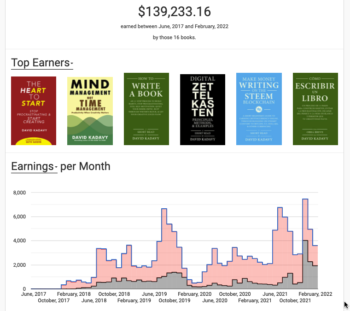
That’s nearly $140,000 earned, in the little more than 4 years that I’ve been self-publishing. Not bad! And, as you can see in that graph, sales are growing.
70,000 books sold
So, how many books have I sold in my lifetime? The number comes out to about 70,000. I made a prediction on PredicitonBook that I’m 80% sure that by two years from now, I’ll cross the 100,000 mark.
In a way, that doesn’t make sense, because I’m ten years into my career as an author, and I’ve sold 70k. Why would I expect to sell 50% more books in about a fifth the time? Well, it’s that snowball effect I was talking about earlier. I could also call it the Foundation Effect. Time will tell if I reach that goal.
Income from the Alliance of Independent Authors
You’ll notice a small payment from the Alliance of Independent Authors under Affiliate Income in this report. That’s for referring a new member.
I recently created an IngramSpark promo code page, in the hopes of attracting some inbound search traffic that would like to join ALLi. The thing is, if someone is going to publish on IngramSpark, it makes a ton of sense to get an ALLi membership just for this promo code. Ingram charges $49 just to set up a book, and $25 per file each time you upload a file – including when you make revisions. That really adds up over time, and this promo code waives that fee.
As of yet, I don’t see great search rankings for this page, but these things take time. If you publish on IngramSpark, join ALLi, and it will quickly pay for itself.
Income
Book Sales
| Mind Management, Not Time Management Kindle | $1,025 |
| Mind Management, Not Time Management Paperback (Amazon) | $1,793 |
| Mind Management, Not Time Management (non-Amazon) | $743 |
| Mind Management, Not Time Management Audiobook | $1,158 |
| Digital Zettelkasten Kindle | $1,029 |
| Digital Zettelkasten Wide (non-Kindle) | $408 |
| Digital Zettelkasten Audiobook | $12 |
| The Heart to Start Kindle | $414 |
| The Heart to Start Paperback (Amazon) | $149 |
| The Heart to Start “Wide” (non-Amazon) | $30 |
| The Heart to Start Audiobook | $50 |
| How to Write a Book Kindle | $197 |
| How to Write a Book Paperback | $333 |
| How to Write a Book “Wide” (non-Amazon) | $9 |
| How to Write a Book Audiobook | $24 |
| How to Write a Book Spanish (all) | $5 |
| Make Money Writing on the STEEM Blockchain (all) | $20 |
| Ten Passive Income Ideas | $8 |
| Total Book Sales | $7,407 |
Digital Products
| Summer of Design | $9 |
| White Hot Course | $99 |
| Total Digital Products | $108 |
Affiliates / Advertising
| Active Campaign | $451 |
| Alliance of Independent Authors | $27 |
| Amazon | $66 |
| Google Adsense | $140 |
| SendOwl | $5 |
| Total Affiliates | $688 |
Love Your Work Podcast
| Patreon | $280 |
| Total LYW Podcast | $280 |
Services
| Clarity | $0 |
| Medium | $7 |
| Total Services | $7 |
| GROSS INCOME | $8,490 |
Expenses
General
| Accounting | $344 |
| Outside Contractors | $0 |
| Podcast Editing / Publishing | $123 |
| Quickbooks | $45 |
| Total General | $512 |
Advertising
| Amazon | $1,976 |
| Influencer Marketing | $500 |
| Product Samples | $22 |
| Prestozon | $50 |
| Total Advertising | $2,547 |
Hosting
| ActiveCampaign | $135 |
| Bookfunnel | $15 |
| Drafts | $2 |
| Dropbox | $10 |
| Evernote | $35 |
| Fathom Analtyics | $14 |
| Libsyn | $7 |
| Namecheap | $28 |
| SendOwl | $9 |
| Ulysses | $7 |
| WP Engine | $96 |
| Zapier | $14 |
| Total Hosting | $372 |
| TOTAL EXPENSES | $3,431 |
| NET PROFIT | $5,059 |



